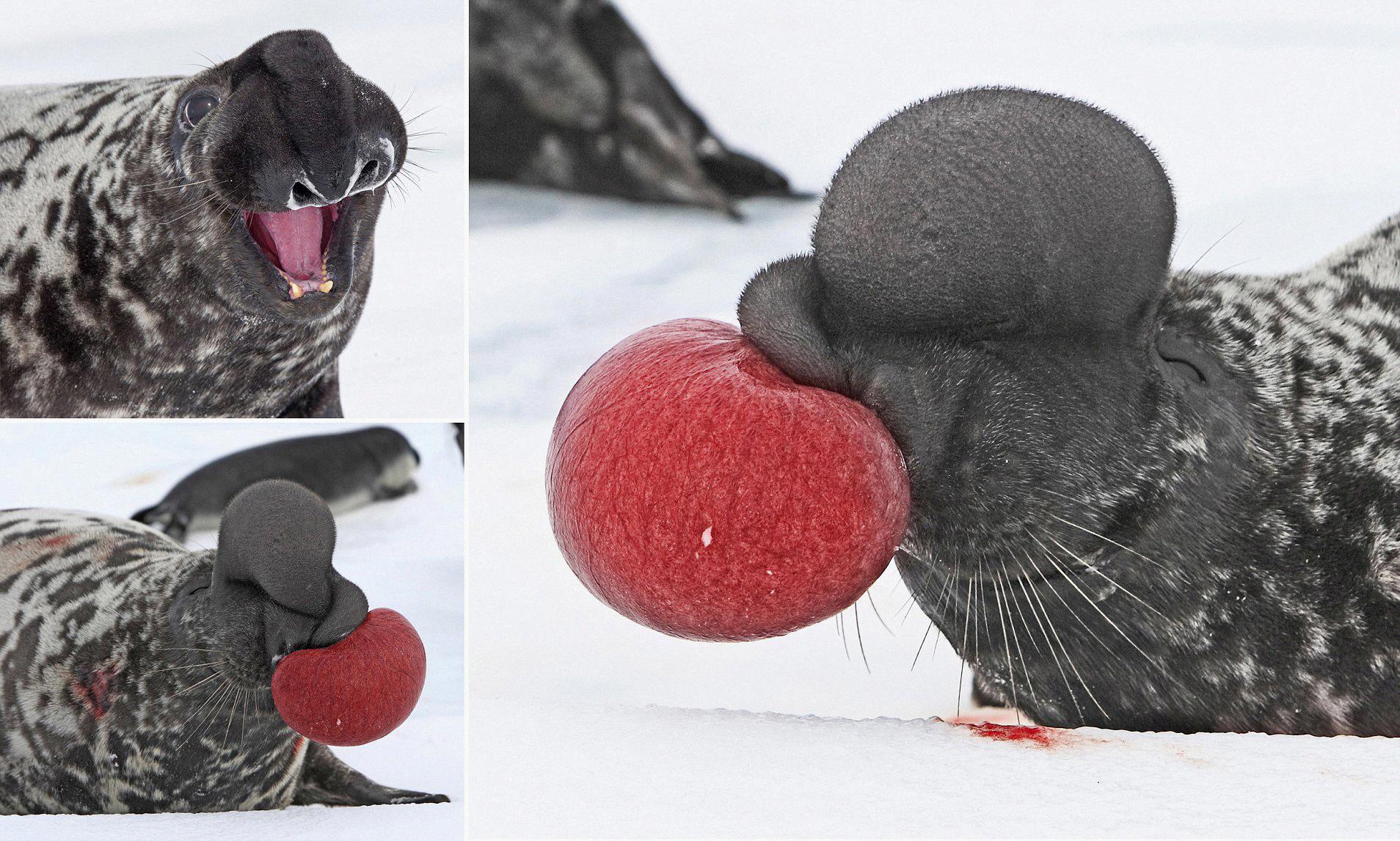Hooded seals are a type of earless seal found in the North Atlantic and Arctic oceans. They get their name from their large, round “hoods” which are used to keep warm in the cold water. Hooded seals are one of the largest types of seals, with males reaching up to 11 feet long and 2000 pounds! Females are slightly smaller, but still impressive, at 9 feet long and up to 1500 pounds. These animals are mostly gray or white, with some darker spots on their backs. Their diet consists mainly of fish, but they will also eat squid, crabs, and other marine creatures.
What Is The Red Thing On The Hooded Seal?
The red thing on the hooded seal is its inflated nasal septum, which is the wall between the two nostrils. Only male hooded seals are able to inflate ther nasal septum this way. It is red because of the blood flowing through the stretched skin.

What Is Unique About The Hooded Seal?
The hooded seal is best known for its uniquely elastic nasal cavity, which is located at the top of its head. This display-worthy nasal sac is only possessed by males, who begin to develop it around the age of four.
What Do Hooded Seals Do?
Hooded seals are known to be aggressive and territorial animals. They use teir inflatable hoods as a way to intimidate other males and show their sexual availability. The hood is located at the nose and can extend up to the top of the head when inflated. When not inflated, it hangs down over the face like a curtain.
What Does Seal Milk Taste Like?
Seals milk is a unique, high-fat dairy product with a strong, fishy flavor. Some people compare the taste to that of a strong cheese, while others say it is more like a nutty butter. Seal milk is rich and creamy, with a high fat content that makes it perfect for use in baking and cooking.
How Many Hooded Seals Are Left?
The total hooded seal population is crrently estimated to be 650,000, consisting of 250,000 in the Northwest Atlantic, 200,000 in the Western Arctic, 150,000 in the Eastern Arctic, and 50,000 in the Svalbard-Barents Sea region.

Why Are Hooded Seals Endangered?
Hooded seals are endangered for a variety of reasons. They are hunted illegally despite beig protected under the Marine Mammal Protection Act, and they often get caught in gillnets. Additionally, overfishing has led to a decline in the availability of food for these seals, causing them to migrate further south in search of sustenance.
How Do Hooded Seals Communicate?
Hooded seals communicate primarily through sounds made by ther hood and nasal septum. They produce pulses that range from 500 to 6 Hz, which can be heard both in the water and on land. To create these sounds, they move their inflated hood and septum up and down. This produces “pings” and “whooshes” that help the seals communicate with each other.
Where Do Hooded Seals Give Birth?
The hooded seal (Cystophora cristata) is a species of earless seal found in the Arctic and sub-Arctic regions. They follow an annual cycle of movement that keeps them in association with drifting pack ice. They breed during the spring in three traditional areas — off the east coast of Canada, in the Davis Strait, and in the West Ice (between Greenland and Iceland). After giving birth on land or ice, the females return to the water, leaving their pups behind. The pups are born with a thick white coat, which they shed after a few weeks.
What Would Happen To The Hooded Seal Of The Sea Ice Decrease?
Hooded seals are found in the North Atlantic Ocean, typically around Newfoundland and Greenland. They spend most of their time on the sea ice, where they breed and give birth.
A decrease in sea ice would reduce the habitat available to hooded seals. This could result in a decrease in the population, as well as an increase in mortality rates amog pups. Additionally, early ice breakup could cause premature separation of mothers and pups, leading to higher death rates among newborns.

How Long Does The Hooded Seal Nurse?
Hooded seals have the shortest lactation period of any mammal, with most pups nursing for only 4 days. Pups weigh an average of 48 kg (105 lbs.) at weaning, and on average double ther birth mass in the short nursing period.
How Does A Seal Adapt To Its Environment?
Seals are very well adapted to their cold polar environments. They have thick blubber layers which act as both a food reserve and insulation against the cold. Most seals also have a layer of fur, giving them additional insulation on land.
How Many Seals Are Left In The World?
It is estimated that there are between 2 million and 75 million seals in the world. This estimate is based on the number of seals estimated to be in existence by the International Union for Conservation of Nature (IUCN). The IUCN is a global organization that works to protect and conserve nature.
What Are Some Fun Facts About Seals?
1. Seals are reated to bears, skunks, and badgers.
2. “Earless” true seals actually do have ears.
3. The largest seal weighs more than four tons.
4. Mothers and pups bond with a unique call.
5. They have “smokers’ blood” to help survive deep dives.
How Many Seals Are Left In The Arctic?
The Arctic ringed seal is the only species of seal that is endemic to the Arctic Ocean. The current population size for this species is estimated to be over 300,000 individuals.
